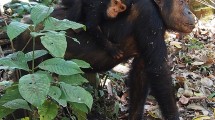Abstract
K Group, originally one of the two major study groups of chimpanzees since 1965 in the Mahale Mountains National Park, western Tanzania, was almost extinct by 1983: at most seven individuals remained in the group at the beginning of 1983. K Group continued to exist for more than four years, but in 1987 a male was left alone at the age of 15 after all the other chimpanzees of the group emigrated or disappeared. Since then he has been observed sporadically for more than five years only within the former range of K Group, without having any contact with the many resident chimpanzees of the neighboring M Group, the other major study group. The present observations reconfirm the strong philopatric tendency of adult male chimpanzees.
Similar content being viewed by others
References
Goodall, J., 1983. Population dynamics during a 15 year period in one community of free-living chimpanzees in the Gombe National Park, Tanzania.Z. Tierpsychol., 61: 1–60.
—, 1986.The Chimpanzees of Gombe: Patterns of Behavior. The Belknap Press of Harvard Univ. Press, Cambridge, Massachusetts.
—,A. Bandora, E. Bergmann, C. Busse, H. Matama, E. Mpongo, A. Pierce, &D. Riss, 1979. Intercommunity interactions in the chimpanzee population of the Gombe National Park. In:The Great Apes,D. A. Hamburg &E. R. McCown (eds.), Benjamin/Cummings, Menlo Park, pp. 13–53.
Harcourt, A. H., K. J. Stewart, &D. Fossey, 1976. Male emigration and female transfer in wild mountain gorilla.Nature, Lond., 263: 226–227.
Hayaki, H., 1988. Association partners of young chimpanzees in the Mahale Mountains National Park, Tanzania.Primates, 29: 147–161.
Hiraiwa-Hasegawa, M. &T. Hasegawa, 1988. A case of offspring desertion by a female chimpanzee and the behavioral changes of the abandoned offspring.Primates, 29: 319–330.
Itani, J., 1980. Social structure of African great apes.J. Reprod. Fertil., Suppl., 28: 33–41.
Kawanaka, K., 1984. Association, ranging, and the social unit in chimpanzees of the Mahale Mountains, Tanzania.Int. J. Primatol., 5: 411–434.
—, 1989. Age differences in social interactions of young males in a chimpanzee unit-group at the Mahale Mountains National Park, Tanzania.Primates, 30: 285–305.
Nishida, T., 1979. The social structure of chimpanzees of the Mahale Mountains. In:The Great Apes,D. A. Hamburg &E. R. McCown (eds.), Benjamin/Cummings, Menlo Park, pp. 73–121.
—, 1983. Alpha status and agonistic alliance in wild chimpanzees (Pan troglodytes schweinfurthii).Primates, 24: 318–336.
—, 1990. A quarter century of research in the Mahale Mountains: an overview. In:The Chimpanzees of the Mahale Mountains: Sexual and Life History Strategies,T. Nishida (ed.), Univ. of Tokyo Press, Tokyo, pp. 3–35.
— &M. Hiraiwa-Hasegawa, 1985. Responses to a stranger mother-son pair in the wild chimpanzee: a case report.Primates, 26: 1–13.
—, —,T. Hasegawa, &Y. Takahata, 1985. Group extinction and female transfer in wild chimpanzees in the Mahale National Park, Tanzania.Z. Tierpsychol., 67: 284–301.
—, &K. Kawanaka, 1972. Inter-unit-group relationships among wild chimpanzees of the Mahali Mountains.Kyoto Univ. Afr. Studies, 7: 131–169.
—,H. Takasaki, &Y. Takahata, 1990. Demography and reproductive profiles. In:The Chimpanzees of the Mahale Mountains: Sexual and Life History Strategies,T. Nishida (ed.), Univ. of Tokyo Press, Tokyo, pp. 63–97.
Pusey, A., 1979. Intercommunity transfer of chimpanzees in Gombe National Park. In:The Great Apes,D. A. Hamburg &E. R. McCown (eds.), Benjamin/Cummings, Menlo Park, pp. 465–479.
—, 1990. Behavioural changes at adolescence in chimpanzees.Behaviour, 115: 203–246.
Sugiyama, Y., 1989. Population dynamics of chimpanzees at Bossou, Guinea. In:Understanding Chimpanzees,P. G. Heltne &L. A. Marquardt (eds.), Harvard Univ. Press, Cambridge, Massachusetts, pp. 134–145.
Takahata, H. &Y. Takahata, 1989. Inter-unit group transfer of an immature male of the common chimpanzee and his social interactions in the non-natal group.Afr. Study Monogr., 9: 209–220.
Takahata, Y., 1985. Adult male chimpanzees kill and eat a male newborn infant: newly observed intragroup infanticide and cannibalism in Mahale National Park, Tanzania.Folia Primatol., 44: 161–170.
Uehara, S., 1981. The social unit of wild chimpanzees: a reconsideration based on the diachronic data accumulated at Kasoje in the Mahale Mountains, Tanzania.Ahurika-Kenkyu (J. Afr. Studies), 20: 15–32. (in Japanese with English Summary)
—,M. Hiraiwa-Hasegawa, K. Hosaka, &M. Hamai, 1994. The fate of defeated alpha male chimpanzees in relation to their social networks.Primates, 35: 49–55.
Yamagiwa, J., N. Mwanza, A. Spangenberg, T. Maruhashi, T. Yumoto, A. Fischer, &B. Steinhauer-Burkart, 1993. A census of the eastern lowland gorillasGorilla gorilla graueri in Kahuzi-Biega National Park with reference to mountain gorillasG. g. beringei in the Virunga region, Zaire.Biol. Conserv., 64: 83–89.
Author information
Authors and Affiliations
About this article
Cite this article
Uehara, S., Nishida, T., Takasaki, H. et al. A lone male chimpanzee in the wild: The survivor of a disintegrated unit-group. Primates 35, 275–281 (1994). https://doi.org/10.1007/BF02382725
Received:
Accepted:
Issue Date:
DOI: https://doi.org/10.1007/BF02382725




